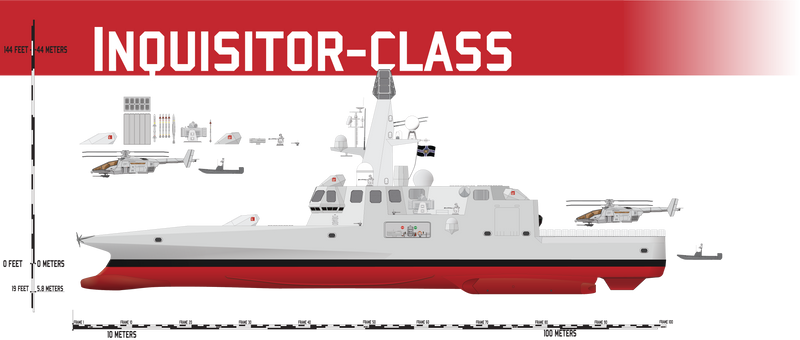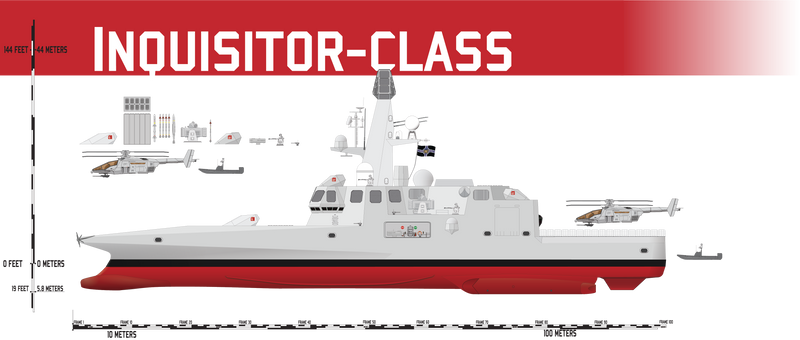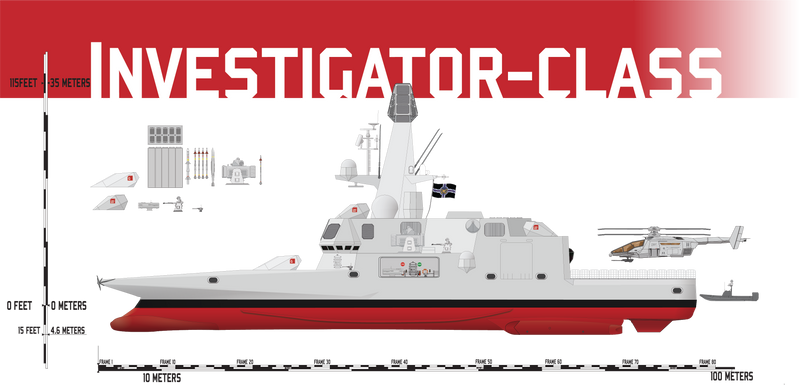Imperator-class Frigate
Go To Halcyon Arms Storefront For Purchase
[CREATED AS A COMMISSION FOR TOPSAIL EMPIRE]
[CREATED AS A COMMISSION FOR TOPSAIL EMPIRE]
IMPERATOR-CLASS
GUIDED MISSILE FRIGATE
GUIDED MISSILE FRIGATE

Deviantart Page
RESTRICTION LEVEL TWO
Unit Cost:$1.8 Billion
DPR Cost: $70 Billion
Imperator-class Frigate
Stats:
Class: FFGN, (Guided Missile Frigate/Nuclear)
Hull Style: Trimaran
Length: 471 feet
Width: 112 feet
Height: 144 feet (from waterline) 163 feet (with draft)
Draft: 19 feet*
Tonnage: 8,600†
Speed: 29 knots
Aircraft: 3† (Up to 5)
Boats: 3 RHIBS
Ship's Force: 116†
Air Wing: 12†
Deployed Forces: 36 Troops
Armament:
70 VLS Tubes
2 Triple-Torpedo Tubes
1 Dual-Barrel Advanced Gun System/CIWS
8 Large Quadruple AShM launchers
Defenses:
3 30mm Shield CIWS
2 25mm Mk3 Rapier Defense Autocannons
6 .50-cal Dagger ROADS
3 NRAM-32 Longsword (24 Missiles each)
60 Active Anti-Torpedo Decoy-Explosives
2 Active SONAR Decoys, towed
8 .50-cal Machine gun posts
Full Command Electronic Warfare & Deterrence Suite
Power & Propulsion
Power Source: 1 FF2H1 350Mw PWR
Back up Source: 3Mw Diesel Generator
Battery Back up: 12 Hour life, 4 for propulsion
Propulsion: 2 Asimov Engineering FFV-4 Motor-Propulsors
Secondary Propulsion: 2 Extending Maneuvering Azipods
Air:
1 Helipad
2 Small Helicopter Hangar
*Pending speed and load
†: Denotes ideal specification
DESCRIPTION
Constructed by the Pharthanian companies of Halcyon Arms and Asimov Engineering and done as a collaboration with Red Wolf Industries of the Topsail Empire, the Imperator-class attempts to bridge the gap between the roles of Frigate and Destroyer, essentially filling the role of Escort Destroyer and Anti-Air Warfare escort, and can operate effective in litorrals and out at sea as an escort for larger vessels or a patrol vessel. Though relatively small, the Imperator-class packs a punch and is capable of launching massive Anti-Ship missiles to knock out enemy capital ships. It maintains a relatively stealthy profile to help assist it appear as little more than a fishing vessel, but stealth is far from it's focus and sacrifices stealth for an array of radar, communications, and electronics warfare suite that compare to larger destroyers.
The Imperator sports the ability to carry helicopters for Anti-submarine duties with two triple-torpedo launchers on the sides to assist it's aircraft and a large sonar array. To further help it in submarine killing, the Imperator itself can "go silent" just as it's prey can, making it a true predator. Operating at low power on it's single FF2H1, it's reactor can be operated in natural circulation; the FF2H1 reactor is already far overpowered for what would be necessary for such a frigate, meaning that such lower powers still allow it full electrical capacity and the ability to achieve approximately twelve knots in "silent mode," equal or greater than many of it's subsurface prey in similar states.
The Defensive Suite of the Imperator is composed of four tiers. The outermost layer is comprised anti-air missiles and strike-missiles launched from VLS tubes, able to strike over the horizon and defend against long-range targets. The third tier is manned by rolling-airframe missiles with a range of nearly 12 miles; they can be programmed for several kill modes to take out a variety of targets. The second tier, closely related to it's first lies with it's 57mm dual-barrel cannon, capable of firing programmable rounds as both an offensive and defensive weapon. Finally, the inner tier is comprised of 30mm, 25mm autocannons and 12.7mm machine guns. The 25mm autocannons and 12.7mm cannons are not designed for point-defense, though they can be utilized as such. The 30mm CIWS is sufficient for kills at two miles of range.
To assist it's scouting abilities, it can also launch small UAVs both off of rails and by hand and from the rear helipad. The Helipad is large enough to carry two smaller helicopters or one larger helicopter, and it has hangar capability to hold two helicopters. Ideally for blue-water operations only two helicopters are utilized and stored in hangars, though for green-water roles the Imperator can man four helicopters.
- Warfare Roles of the Imperator-class
- Strike (Surface-to-Ground)
- Naval (Surface-to-Surface)
- Anti-Submarine
- Anti-Air
- Anti-Ballistic Missile
- Electronic Warfare
FF2H1 Pressurized Water Reactor Plant
350 MW
FF2H1 Stands for:
- FF: Frigate platform
- 2: Contractors second design generation
- H: Halcyon Arms. Contracted Designer
- 1: First iteration of the present Reactor Design.
The FF2H1 is a Pressurized Water Reactor utilizing nuclear fission for the purpose of heat production to be used to create steam for usable work. The FF2H1 is jointly designed and built by Halcyon Arms and Asimov Engineering. The FF2H1 is meant to provide considerable power to a smaller vessel in a more combat reactor design Core life is expected to be twenty years, depending on operations, maintenance, and modifications made. Utilized for only electrical power, the core may last for up to 60 years. The reactor core is rated to 350 MW production capacity and utilizes highly enriched uranium as fuel. The Uranium is made into uranium oxide pellets which are then clad in zircaloy to make fuel-plates, which are stacked with gaps between them (for coolant to pass through), and made into assemblies, which are then assembled around a center channel design for the control rod to pass through, making a fuel assembly. This fuel assembly is immobile within the core.
The FF2H1 is a two-loop reactor plant design, using highly pressurized and purified water as both coolant and moderator. The heated coolant passes through a boiler unit, heating it's water to produce steam. This water is then pumped back to the core by a reactor coolant pump, one per loop, where it passes around the reactor vessel, mixing with water from the other loop and then through a colander to ensure proper mixing of the coolant and filtration of debris, should any exist. From the colander the water passes up through the first-pass fuel channels for the initial heating, then out, around, and down the fuel assemblies to again pass upwards through the second-pass fuel channels, heating up the coolant further before ejecting it into the outlet region, where the coolant is sent back through towards the boiler units. The boilers provide steam for five turbine generators, two of which are used to power the reactor coolant pumps, and the other three powering the Common Electrical Distribution System.
Due to using water as a coolant/moderator, the reactor achieves natural stability. If the reactor experiences an up-power transient the coolant heats up further it will be less dense and moderate fewer neutrons, so more neutrons will escape the core, again lowering reactor power back to it's original state. The only process, therefore, which will change reactor power and maintain it steady-state at that new power is a change in steam-demand, save for massive introductions of poisons which drive the reactor out of it's power range, such a protective "Scram". Conversely, other factors can change temperature, namely the introduction of poisons, to include control rods. Control rods are used for reactor control as well as protection; in the event of a loss of power they will automatically scram (insert to the bottom of the core, shutting it down completely). This can also be done by the operator or by automatic action in the event of other casualties as well. Additional safety features include automatic filling of the reactor, should the core become depressurized and risk becoming uncovered, which would mean a lack of coolant and would allow for potential meltdown. With this, significant release of fission-product contamination external to the hull of the ship is guarded against.
The FF2H1 is capable of operating up to 20% power without powering it's reactor coolant pumps; this natural circulation can be used for both decay heat removal and low power operations, making the reactor plant relatively quiet, but this natural circulation also provides for power transient-response and is not suitable for combat operations. As they are easy to cool without operator action or electrical power, the FF2H1 is remarkably safe when shutdown. This also means that the reactor plant can perform a battery-only start-up, which is highly valuable for combat scenarios or a loss of all reactor plants simultaneously.
Radiation shielding is required and makes up the outside of the reactor compartment, which houses the reactor, boiler units, coolant loops, reactor coolant pumps, pressurizer, and filtration system. The shielding is made up of borated poly, water tanks, steel, and lead. It also has photovoltaic cells lining the inner wall to provide a trickle-flow of electricity to power the ship's battery and auxiliary reactor-plant batteries. With the reactor at power this trickle flow can be used to maintain supply of electricity to critical components. Entering this reactor compartment while the reactor is at power is considered to be deadly, but the layered shielding is so sufficient that personnel working in the propulsion plant will receive less radiation than those working on the weatherdecks of the vessel.
In the event of a loss of power, several emergency diesel generators can provide auxiliary power. This are primarily designed to support the reactor plant's automatic fill protection system, but they can also be aligned to the common electrical distribution system for propulsion power.
Amenities:
Crew amenities, for the most part, are as standard with any Pharthan Navy ship. Each individual sailor is allotted their own "Coffin-Rack," which storage underneath the rack, which sits in a tray that can be lifted to expose personal storage space, as well as a personal locker. Each rack space comes with a personal reading light, towel-hangar, emergency egress breathing device stowage, personal six-outlet power strip, and a state-of-the-art Smart Reveille Suite, or SRS.
The SRS monitors the sleep pattern of the sailor, and can be programmed in with the applicable Watchstation Schedule, Morning Routine & Muster, et cetera. For those requiring certain amounts of sleep such as pilots, it can also advise the sailor on when they should be falling sleep. The SRS is a built in computer roughly the size of a smart-phone, built into the rack itself and is tamper resistant. It also includes vibration sensors which are, as a standard, built into the walls and base of the rack, as well as separate remote sensors to be able to differentiate natural ship motion from the motions of the sailor.
To promote healthy sleep, the SRS will begin playing soft music of the sailor's choice to ease them awake within the optimal period prior to their next appointment, as well as emitting "peaceful" light.
In the event the sailor is late for watch or muster, a louder alarm and brighter lights will be emitted.
The speakers for the sounds are directed inward, and additional sound-proofing is provided to prevent disturbing other sailors.
While differing on each ship and in each compartment slightly, each berthing location houses between eight and 12 enlisted sailors. Officer berthings may be singular, double, or a quartet, depending on rank and station. Each berthing space comes with one computer, which, when available, is linked to the ship's internet and unclassified network; internet browsing on this network is often limited for security reasons, though general social media is allowed. A separate web-browser notebook is also provided to allow sailors to download movies, games, videos, et cetera, and more extensive chat with family. While still monitored for security reasons, this is not connected to the ship's unclassified data network and is more free to use.
Each berthing space has an ample amount of electrical outlets and storage space, both communal and personal, to allow for personal gaming systems, and each berthing space has one large flatscreen TV, with space for an extra. Additionally, every berthing space has their own minifridge and microwave oven.
For every forty sailors there is an additional community space, allowing for more activities to include the watching of movies, TV, gaming, et cetera, without disturbing those sleeping at the time.
For every sixteen sailors there is at least one head, to include two showers, two toilet stalls, and three sinks, though some areas may include more based on availability. These are often of stainless steel construction for sanitary reasons, and the shower-stalls are curtained off, though some may include a hard vanity door.
Gym services include rowing machines, various styles of treadmills, weight machines and racks, yoga mats and equipment, sports equipment for any open areas, and more at the request of the ship's recreational officers.


